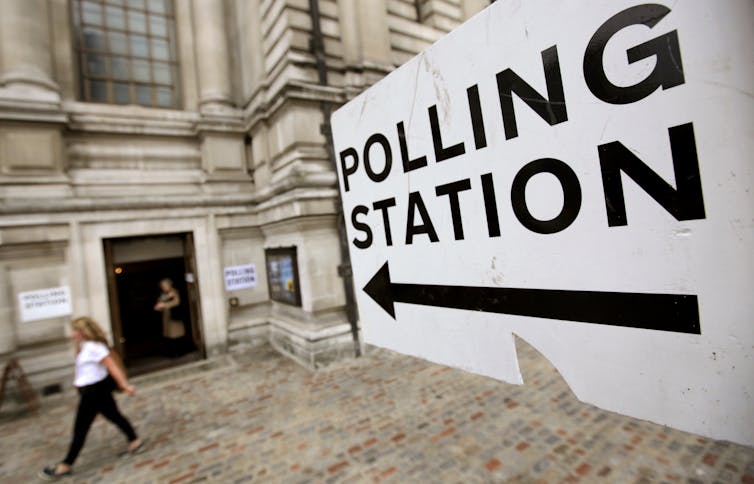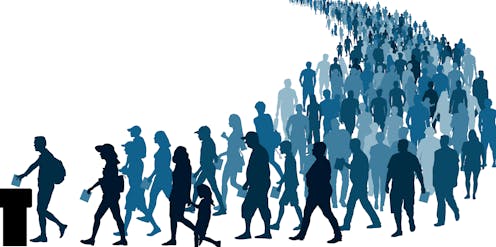Britain is once again going to the polls – and encouraging people to vote may be as important this year as asking them to vote for a particular party.
Traditionally, low turnout has a disproportionate affect on Labour votes – as Labour’s voters tended to be younger and more working class than the that of the Conservatives. Both these groups were, traditionally, less likely to vote. However, this is potentially less and less the case in an era of partisan dealignment.
The Conservatives have still shown themselves to be concerned that high turnout benefits their rivals in recent elections but class-based political allegiances have shifted. A Conservative vote is no longer so readily associated with affluence – indeed one poll at the start of the campaign predicted that the Conservatives were winning more support from the working class than the upper class.
How and who?
Turnout in general elections has declined from heights of 80% in the early 1950s to a nadir of under 60% in 2001. However that doesn’t mean the trend is linear. Indeed, since 2001, turnout has increased. It even hit 68.8% in 2017. This can partly be explained by how tight many of the recent elections have been. When people can see a result could be close, they are more likely to perceive each vote as mattering more, which incentivises them to take part. And in the three most recent UK elections, two have failed to produce a majority government. Before 2010, only one election since universal suffrage produced a hung parliament – in February 1974.
The timing of the election is also important. In the case of 2019, it was initially feared that holding an election in December, when the weather is cold and the days short, would boost Conservative votes because the cold weather might discourage people who don’t feel strongly about voting from taking part (especially of those too young to have developed strong partisan loyalties). However, others argued the opposite, fearing that bad weather conditions could deter older (and therefore potentially more Conservative leaning) voters from turning out.

And aside from weather, the timing of this election is also politically sensitive. Opposition parties in particular were determined this election should take place during university term time, when students are gathered in single geographical locations. This encourages student turnout, at their university addresses. It also offers opposition parties a double chance of encouraging students – who are predominantly anti-Conservative in outlook – to vote tactically by deciding whether their vote is more optimally cast at home or at their term-time constituency. Labour campaign group Momentum even launched a digital tool to help students determine where they should vote to achieve greatest political impact.
The student vote is seen as central to an effort to unseat prime minister Boris Johnson in his Uxbridge and South Ruislip constituency and in helping Labour’s hold on seats such as Canterbury, which the party won for the first time in 2017. Johnson and his team previously suggested the date for an should be election October 15 in an attempt to limit the number of students registering at their university residences.
Corbyn and the Labour Party were also highly active in encouraging voter registrations through social media posts. These targeted younger voters who traditionally turnout to vote in lower numbers than their older counterparts. Young people are also more inclined to vote for the Labour Party, which is perhaps why it promised in its manifesto to introduce automatic voter registration and extend the franchise to 16 year olds.
The anxiety over these issues partly comes from the knowledge that the effects of high turnout are by no means equal – knowing that Labour is generally the benefactor. Some have argued that higher levels of turnout in the 2017 general election helped the Labour Party increase its vote to 40% – up a whopping 9.5% on its 2015 share.
One reason given for this was the increase in the number of young people – who traditionally do not vote – turning out. Though the role they played remains a topic of debate.
Predicting turnout
Explorations of turnout are important in assessing who is and isn’t likely to vote. Historically divides have occurred between older and younger voters, with the former far more likely to cast a ballot. In 2005 only 7% of ballots were completed by 18-24 year olds while the over-65s cast a quarter of ballots. Poorer voters are also less likely to vote than their wealthier neighbours.
Amid recent polling that shows Labour’s inroads into the Conservative lead may be halting, this may offer some warm relief to Jeremy Corbyn. While underestimating turnout levels have been blamed for a failure to predict Labour’s surge in 2017 it should be noted that some experts were highlighting such weaknesses ahead of the election results. If Labour hopes that young people will surprise by turning out in far higher numbers than expected, it may well be disappointed. The majority of polling companies have changed their methodology, replacing age-based prediction models with those that focus on what respondents say about how likely they are to vote. So they may well have a much more accurate assessment of what turnout will be in 2019.



